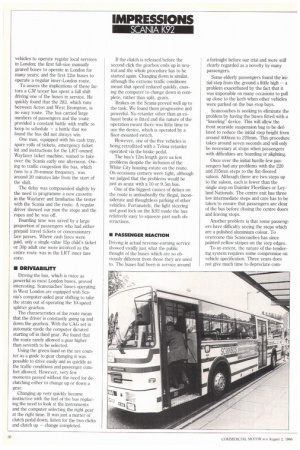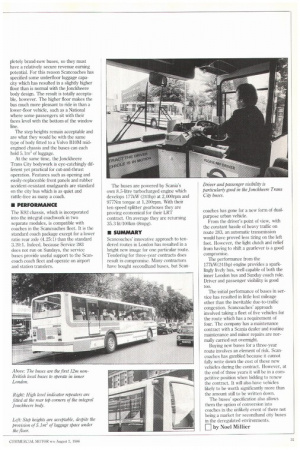CONTINENTAL IN THE CAPITAL
Page 31

Page 32

Page 33

If you've noticed an error in this article please click here to report it so we can fix it.
Scancoaches' single-deck buses may look incongruous running on LRT's Route 283 in West London; we find out how well suited they are to this role
• Slowly but surely the process of putting London bus routes out to competitive tender is changing the image of London bus services. Gradually, the monopoly of the traditional big red bus is being broken.
The process started well over a year ago with Len Wright's London Buslines taking over route 81 with its bright yellow Fleetlines, and with Crystala operating its cream and blue midis in the suburbs. One result is that in some areas the bus scene is much more colourful, with green buses and blue buses as familiar as the traditional red ones. Perhaps the biggest break with convention has resulted from Scancoaches winning the contract to operate the 283 in West London. Unlike most of the successful tenderers which have opted to use traditional double-deckers (except where small buses have been a specific requirement) Scancoaches went in with a view to specifying new buses both to be compatible with its coach fleet and meet the requirements of London Regional Transport and its passengers.
The vehicles the company has chosen are five very continental-looking Scania K92 single-deckers fitted with Jonckheere Trans-City bodywork. The buses represent several firsts for London bus operation: they are the first full-size new buses bought specifically for a LRT tendered service; the first foreign-bodied vehicles to operate regular local services in London; the first full-size manually geared buses to operate in London for many years; and the first 12m buses to operate a regular inner-London route.
To assess the implications of these factors a CM tester has spent a full shift driving one of the buses in service. He quickly found that the 283, which runs between Acton and West Brompton, is no easy route. The bus carried large numbers of passengers and the route provided a constant battle with traffic to keep to schedule — a battle that we found the bus did not always win.
One man, equipped with his cash tray, spare rolls of tickets, emergency ticket kit and instructions for the LRT-owned Wayfarer ticket machine, waited to take over the Scania early one afternoon. Owing to traffic congestion the bus, which runs to a 20-minute frequency, was around 20 minutes late from the start of the shift.
The delay was compounded slightly by the need to programme a new cassette in the Wayfarer and familiarise the tester with the Scania and the route. A regular driver showed our man the stops and the ropes and he was off.
Boarding time was saved by a large proportion of passengers who had either prepaid travel tickets or concessionary fare passes. Where cash fares were paid, only a single-value 15p child's ticket or 30p adult one were involved as the entire route was in the LRT inner fare zone.
• DRIVEABILITY
Driving the bus, which is twice as powerful as most London buses, proved interesting. Scancoaches' buses operating in West London are equipped with Scania's computer-aided gear shifting to take the strain out of operating the 10-speed splitter gearbox.
The characteristics of the route mean that the driver is constantly going up and down the gearbox. With the CAC, set in automatic mode the computer dictated starting off in third gear. We found that the route rarely allowed a gear higher than seventh to be selected.
Using the green band on the rev counter as a guide to gear changing it was possible to drive easily and as quickly as the traffic conditions and passenger comfort allowed. However, very few moments passed without the need for declutching either to change up or down a gear.
Changing up very quickly became instinctive with the feel of the bus replacing the need to look at the instruments and the computer selecting the right gear at the right time. It was just a matter of clutch pedal down, listen for the two clicks and clutch up — change completed. If the clutch is released before the second click the gearbox ends up in neutral and the whole procedure has to be started again. Changing down is similar, although the extreme traffic conditions meant that speed reduced quickly, causing the computer to change down in complete, rather than split, gears.
Brakes on the Scania proved well up to the task. We found them progressive and powerful. No retarder other than an exhaust brake is fitted and the nature of the operation meant there was little time to use the device, which is operated by a floor-mounted switch.
However, one of the five vehicles is being retrofitted with a Telma retarder operated via the brake pedal.
The bus's 12m length gave us few problems despite the inclusion of the White City housing estate on the route. On occasions corners were tight, although we judged that the problems would be just as acute with a 10 or 9.5m bus.
One of the biggest causes of delays on the route is undoubtedly the illegal, inconsiderate and thoughtless parking of other vehicles. Fortunately, the light steering and good lock on the K92 made the bus relatively easy to squeeze past such obstructions.
• PASSENGER REACTION
Driving in actual revenue-earning service showed vividly just what the public thought of the buses which are so obviously different from those they are used to. The buses had been in service around a fortnight before our trial and were still clearly regarded as a novelty by many passengers.
Some elderly passengers found the initial step from the ground a little high — a problem exacerbated by the fact that it was impossible on many occasions to pull up close to the kerb when other vehicles were parked on the bus stop bays.
Scancoaches is seeking to eliminate the problem by having the buses fitted with a "kneeling" device. This will allow the front nearside suspension bag to be deflated to reduce the initial step height from around 400mm to 220mm. This procedure takes around seven seconds and will only be necessary at stops when passengers with difficulties are boarding or alighting.
Once over the initial hurdle few passengers had any problems with the 220 and 225mm steps to the flat-floored saloon. Although there are two steps up to the saloon, each is lower than the single step on Daimler Fleetlines or Leyland Nationals. The centre exit has three low intermediate steps and care has to be taken to ensure that passengers are clear of the bus before closing the centre doors and leaving stops.
Another problem is that some passengers have difficulty seeing the steps which are a polished aluminium colour. To overcome this Scancoaches has since painted yellow stripes on the step edges.
To an extent, the nature of the tendering system requires some compromise on vehicle specification. Three years does not give much time to depreciate corn pletely brand-new buses, so they must have a relatively secure revenue earning potential. For this reason Scancoaches has specified some underfloor luggage capacity which has resulted in a slightly higher floor than is normal with the Jonckheere body design. The result is totally acceptable, however. The higher floor makes the bus much more pleasant to ride in than a lower-floor vehicle, such as a National where some passengers sit with their faces level with the bottom of the window line.
The step heights remain acceptable and are what they would be with the same type of body fitted to a Volvo MOM midengined chassis and the buses can each hold 5.11.113 of luggage.
At the same time, the Jonckheere Trans City bodywork is eye-catchingly different yet practical for cut-and-thrust operation. Features such as opening and easily-replaceable front panels and rubber accident-resistant mudguards are standard on the city bus which is as quiet and rattle-free as many a coach.
• PERFORMANCE The K92 chassis, which is incorporated into the integral coachwork in two separate modules, is compatible with coaches in the Scancoaches fleet. It is the standard coach package except for a lower ratio rear axle (4.25:1) than the standard 3.20:1. Indeed, because Service 283 does not run on Sundays, the service buses provide useful support to the Scancoach coach fleet and operate on airport and station transfers. The buses are powered by Scania's own 8.5-litre turbocharged engine which develops 177kW (241hp) at 2,000rpm and 977Nm torque at 1,200rpm. With their ten-speed splitter gearboxes they are proving economical for their LRT contract. On average they are returning 35.3 lit/1001cm (8mpg).
• SUMMARY Scancoaches innovative approach to tendered routes in London has resulted in a bright new image for one particular route. Tendering for three-year contracts does result in compromise. Many contractors have bought secondhand buses, but Scan coaches has gone for a new form of dualpurpose urban vehicle.
From the driver's point of view, with the constant hassle of heavy traffic on route 283, an automatic transmission would have proved less tiring on the left foot. However, the light clutch and relief from having to shift a geariever is a good compromise.
The performance from the 177kW(241hp) engine provides a sparklingly lively bus, well capable of both the inner London bus and Sunday coach role. Driver and passenger visibility is good too.
The initial performance of buses in service has resulted in little lost mileage other than the inevitable due-to-traffic congestion. Scancoaches' approach involved taking a fleet of five vehicles for the route which has a requirement of four. The company has a maintenance contract with a Scania dealer and routine maintenance and minor repairs are normally carried out overnight.
Buying new buses for a three-year route involves an element of risk. Scancoaches has gambled because it cannot fully write down the cost of these new vehicles during the contract. However, at the end of three years it will be in a competitive position when bidding to renew the contract. It will also have vehicles likely to be worth significantly more than the amount still to be written down.
The buses' specification also allows them the option of conversion into coaches in the unlikely event of there not being a market for secondhand city buses in the deregulated environments.
n by Noel Millier












































































